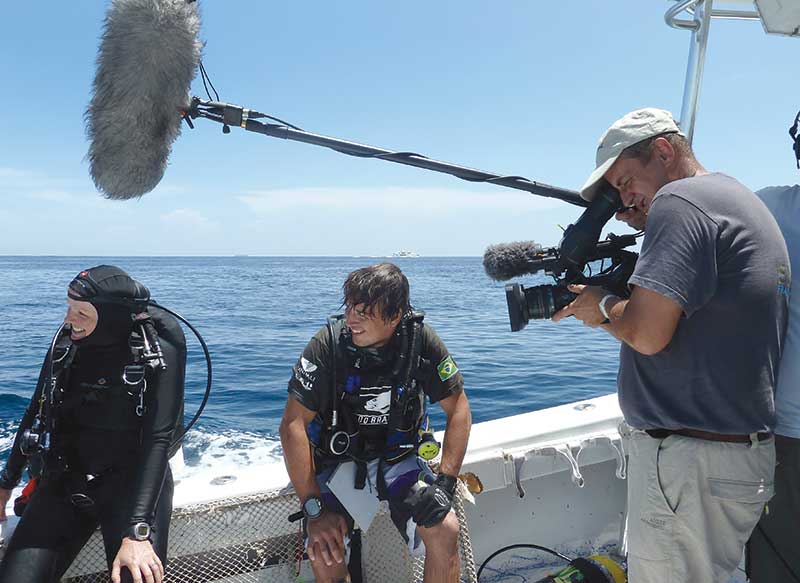A Recipe for Storytelling Success
By Jill Heinerth

Constructing an enjoyable short video is a lot like cooking. Different chefs can use similar ingredients and recipes and still produce completely distinctive meals. Too much hot sauce can render a meal inedible, and a lack of seasoning can make good food seem bland. Small portions might leave you hungry, but excess results in indigestion. I’m offering a recipe for video editing that will help you create a short film that lands right in the Goldilocks Zone—not too hot, not too cold, but just right.
The set-up
The first part of your video establishes a sense of place and time. It also gives you a chance to develop your main character. Perhaps that character is you? If so, take a moment to shoot a quick clip that experts call a ‘piece to camera’ or PTC. A PTC is the television and film term used when a presenter speaks directly to the viewers. The set-up portion of your video should condense to one to two minutes. Keep it short, but convey your excitement and let the audience know where you are going. Hopefully, you arrived early and loaded your gear because you still need to shoot the following scenes before you drop into the water.
Here are some examples:
- Master – Sunrise, tilt up to reveal the boat at the dock, divers walk and load the gear
- B-roll Cutaways (no more than one to three seconds each) – a dive flag, wind in the palms, dive shop sign, etc.
- Medium – Follow divers walking down the dock with their gear
- Close up – Follow divers carrying their gear, focusing on their feet
- Sound – Plinking of tanks loading, engine starts, divers excited, tank valves turned on with a swoosh
- Medium or close – cast off the dock line, crew busy at work
- Wide – Captain at the wheel, departure from dock
- Close up – Captain’s hand on the wheel, radar, map, gauges in the wheelhouse
- B-roll Action Cutaways – Assembling gear: hand turning a tank valve, checking an SPG, a regulator placed on tank, pulling up a wet suit zipper, a diver giving an okay sign, etc.
- Medium – Shoot wider shots of the gear assembly process
- Wide – Reveal divemaster or captain giving parts of a briefing, move in close if they are sharing a map or drawing on a whiteboard
- Wide – Divers shuffle to the transom to jump in the water
- Wide – Divemaster calls “dive, dive, dive!”
- Wide – Divers jump or roll off
- The descent – Technically, this is still part of the set up, but give it 30 seconds or so to build the anticipation of your diving experience. Shoot the following once you are in the water:
- Half in/out – Tilt down to the underwater view as diver makes a giant stride into the water, making a frothy mass of bubbles
- Wide – Cut to the second diver jumping in
- Follow – From above, follow diver down the line to the site
- Point of View (POV) – Wreck or reef coming into sight
- Close up – Face of diver descending
- B-roll – A hand on the line, checking a gauge or releasing air from a wing
The dive
Now you can shoot the core parts of the experience. Mix up master and wide shots to give context with closer shots of points of interest, such as a school of fish, a beautiful sea fan, or a feature on a wreck. Intersperse your wide and master shots with face close-ups, b-roll action like gauge checks, shooting photos, pointing to something, hand signals, etc. Other b-roll shoots might include rising bubbles, looking up at the dive boat overhead, an anchor line bouncing, passing divers, and POVs of the reef or wreck. Your model/dive buddy should be encouraged to gesture, get excited, sweep a light, or signal you about something interesting. Their excitement will carry through to the viewer. Remember to shoot in different viewpoints such as: diver profiles, diver swimming to you, tracking with the diver from beside or above, and following the diver. This section should be about two minutes long for a good dive and longer if the action is remarkable and varied.
Narration
If your dive takes place on a historic wreck or remarkable natural wonder, you can narrate the experience with a voice-over describing the history or features of the site. Don’t fall into the trap of recounting an inventory of things we can see in your video. Let us know how you feel or share relevant points about a theme, history, or phenomenon.
The wrap
Distinctively finish your video with a closing sequence. You can wrap it up with a simple thumbs-up signal or follow a diver up the line as the edit fades to black. If you want to shoot the closing on the boat, you might show two divers doing a high-five, hugging, or yelling out, “That was great!” Remember that emotional expressions are powerful to viewers.
If you have followed the recipe above, then your entire video will land in 3 to 5 minutes, just the right amount of time to feature your best work and retain your audience’s attention. If you are like me, a recipe is a foundation, and the execution is the art. By experimenting with the amounts and ingredients, we can create a dish that is tasty and unique.
Into the planet Jill’s biography is available now through Amazon. For more visit: www.intotheplanet.com
Leave a Comment







